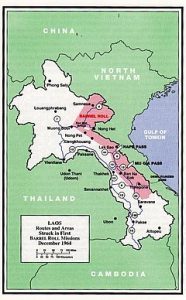On 12 December 1964, Barrel Roll was approved by Souvanna Phouma (the leader of the neutralist faction and Prime Minister of the Kingdom of Laos). The program originally consisted of only two U.S. bombing sorties per week that were to be conducted by no more than four aircraft in each strike. 
Due to the nature of the American agreement with the Thai government (most U.S. strike aircraft flew from bases in Thailand), the aircraft had to first fly to South Vietnam, land, and then take off again for Laos. By 24 December, six-armed reconnaissance missions were being conducted per day, but the expected reaction from Hanoi did not materialize.[15]
The aircraft utilized to support the covert war was an odd assortment of vintage propeller-driven attack aircraft, high-performance jet fighter-bombers, and World War II-era cargo airplanes. This hodgepodge of an air force with its peculiar mix of aircraft and aircrews flew for eight years in the crowded skies over Laos.[6]:117
The majority of the close air support missions flown in the northeast were conducted by Douglas A-1 Skyraiders and AT-28 Trojans. These propeller-driven Korean War-era aircraft came into their own in Southeast Asia, where their heavy ordnance loads, long loiter times, and high maneuverability at low altitudes made them more effective than the “fast movers” of the more modern jet Air Force.(1)
Source: (1) Wikipedia
